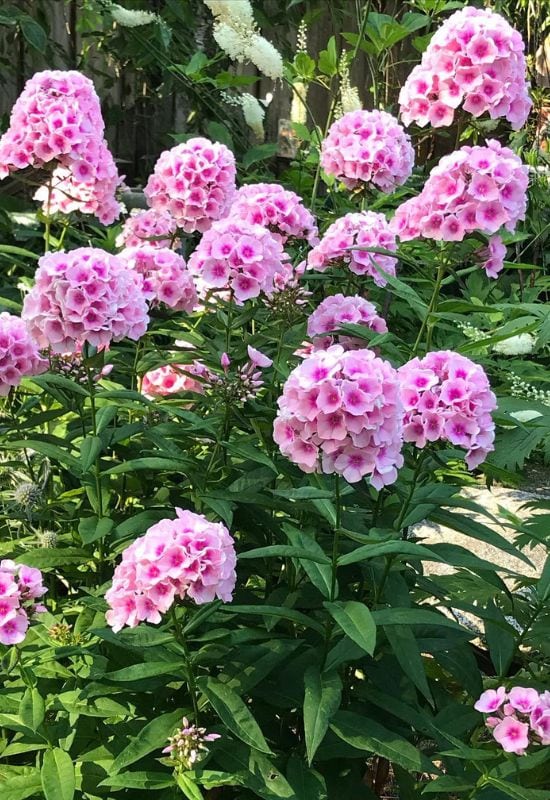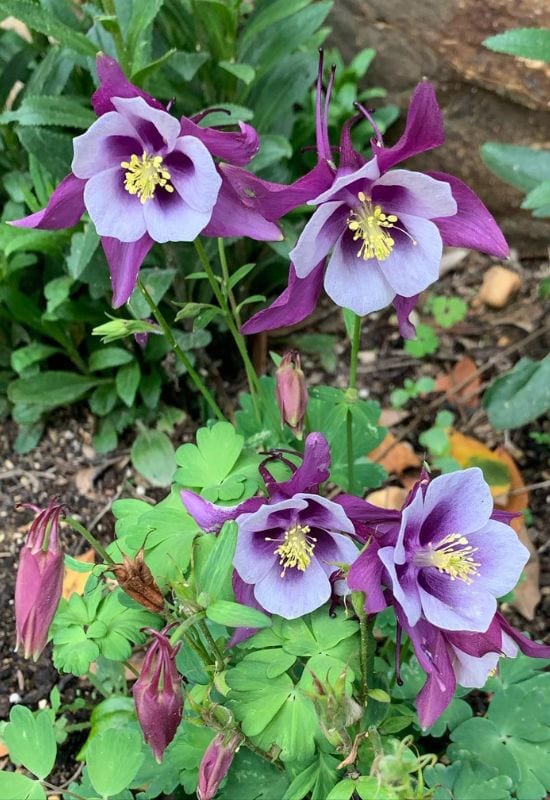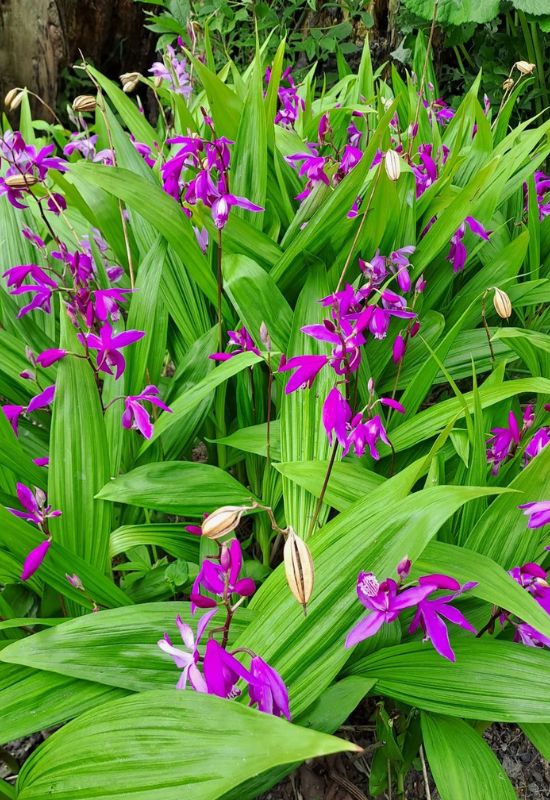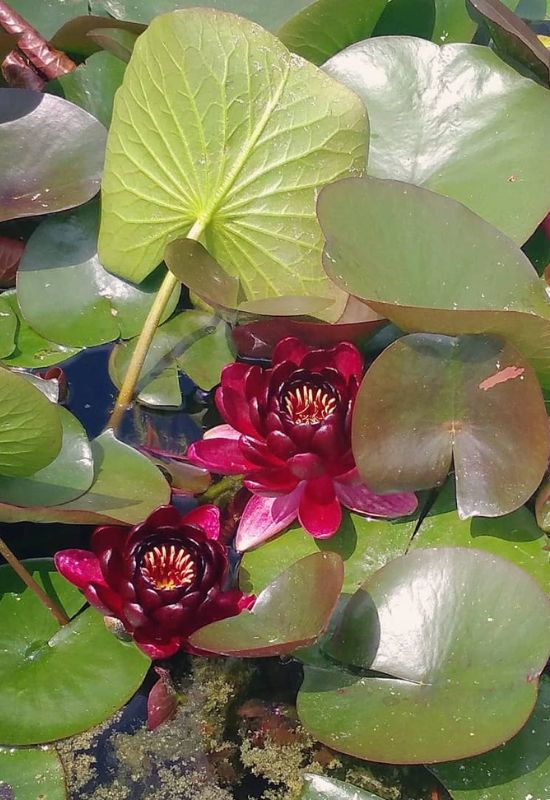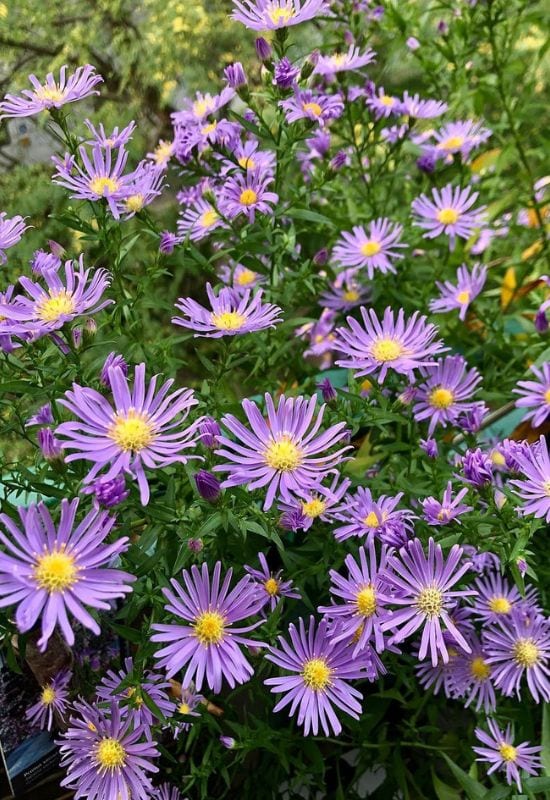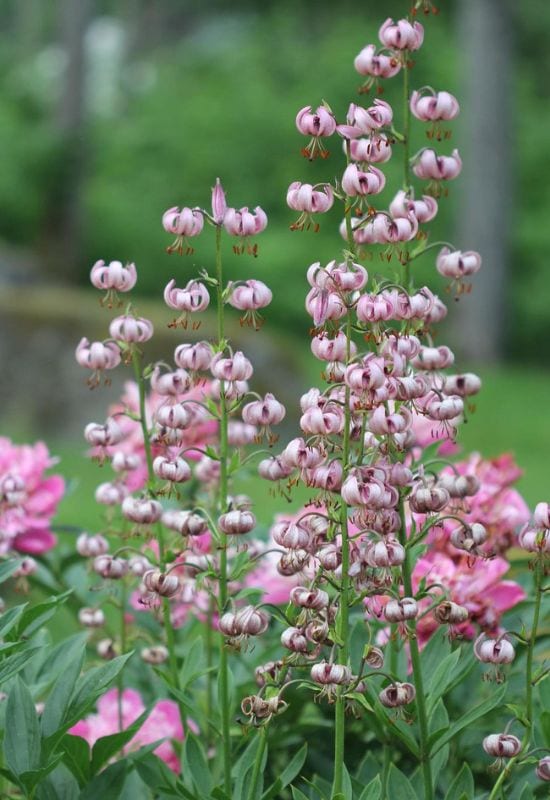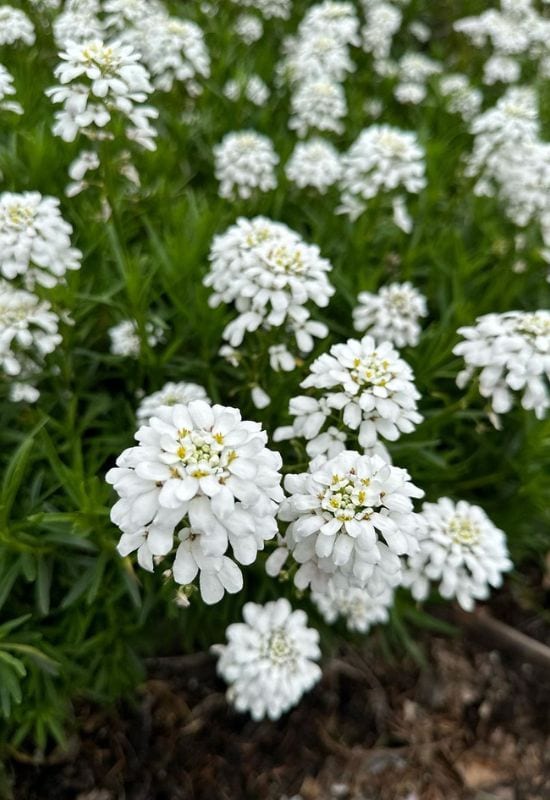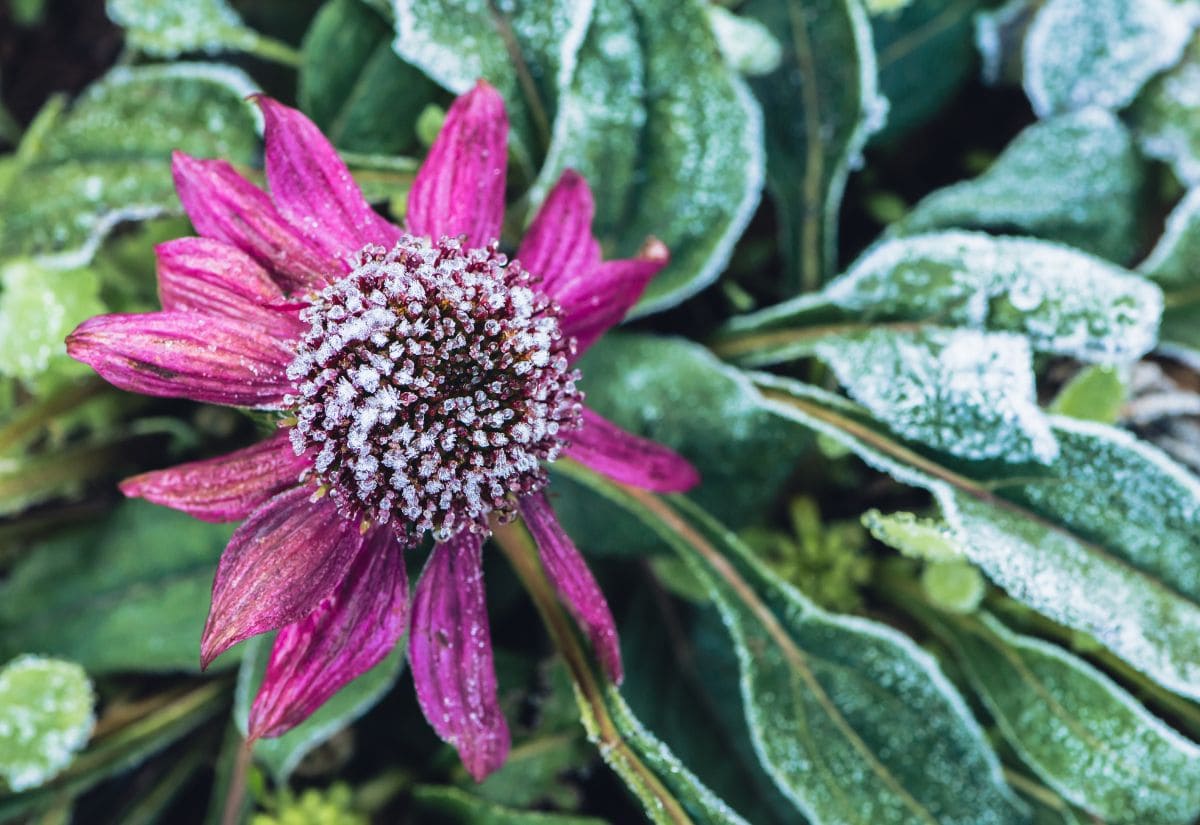
Your garden covers in a white (but cold) blanket of snow in winter? Temperatures drop below freezing, even a lot? …And you worry that your flowering or leafy perennials conditions?
Gardening in those nippy regions, where you’re donning cozy sweaters for most of the year, means you’ve got to arm your garden with the superhero plants.
We’re talking about those frost proof, even friendly perennial varieties that don’t bat an eye when the thermostat dips below 0°C (32°F) or even throws a curveball with those arctic chills of -40°C (-40°F), much like our friends up in the Northern States and Canada experience.
The best part? These cold-hardy beauties come back each year, putting on a spectacular floral show and flaunting their vibrant greens, year after year!
Surprise, surprise! There are a large number of cold-hardy perennials that can withstand not just brief cold spells but also prolonged frost, bringing vibrant hues to your garden during those dreary winter months.
While some freeze proof perennials bloom throughout the winter, lighting up the outdoor garden and pots even in the harshest conditions, others take refuge underground.
They escape the freezing temperatures, only to reemerge with a burst of life in spring or later on. Meanwhile, some plants enter a dormant state but keep their foliage on, even when Jack Frost comes knocking.
It’s amazing, right? Nature always has this incredible knack for finding solutions, ensuring there’s beauty even in the chilliest corners.
So, if you’re as excited as we are, strap in! We’re about to dive deep into this wonderland of frost-friendly perennials, ready to transform your garden into a year-round paradise, filled with vibrant blooms and fresh foliage for a long, long time!
And be assured, they are all striking, and some even exotic! But first of all, let’s spend a few quick words on what frost actually means, and how you could improve the conditions of your perennials if winters go far below average temperatures…
Frost Friendly Perennials: Let’s Get the Numbers Right!
Now, what do we mean by frost? Technically, whenever the temperature drops to or below 0oC, or 32oF. But this is at ground level, while many perennials hide underground during winter and the cold months…
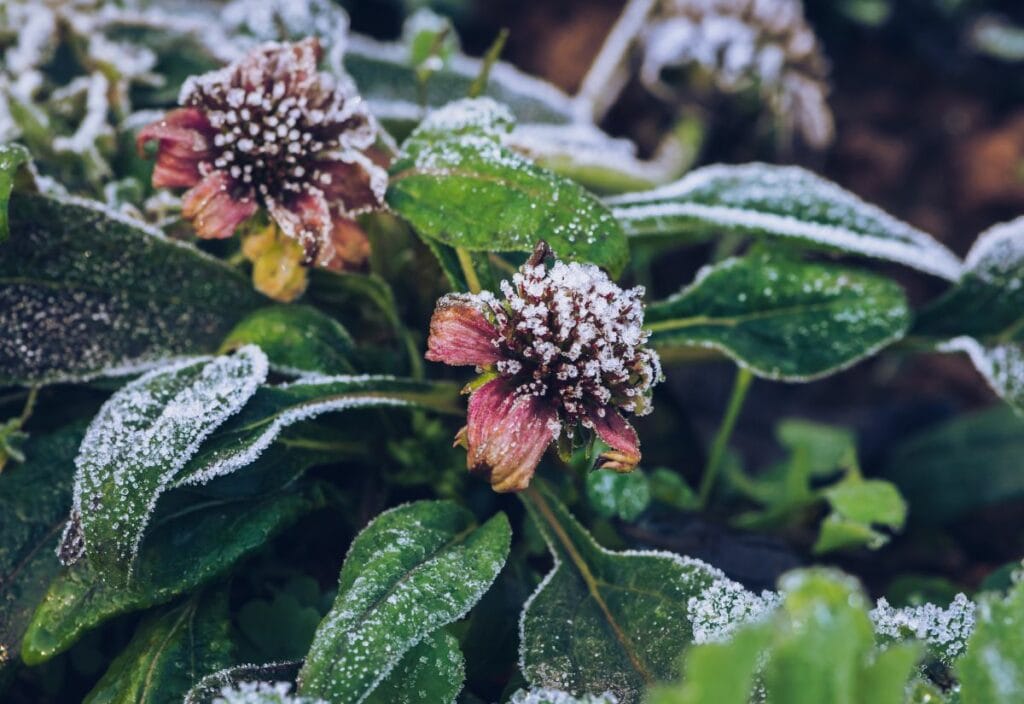
Luckily, most perennial varieties will easily survive these temperatures. In fact, all those species, cultivars and hybrids that are cold hardy to USDA hardiness zone 9 or below! But in colder areas, temperatures can drop to much lower depths, like -40oF (which is also -40oC), and even below. And this is why we have selected very cold hardy varieties of perennials for you, from USDA zone 4 (or 5 in one case) to 2.
This will include all the northern regions of the USA, for example as well as most of Canada.
How to Protect Your Perennials from Severe Frost
But remember that this is for a whole climate zone, but you can have warmer “pockets”, or even build some. How? For example…
But if you want to be really safe, find out some amazing cold hardy, frost friendly perennials that will definitely survive even the harshest winter in your region! And the first is a real star of this season. Let’s meet it!
20 Super Cold-Hardy Perennial Plants That Survive Winter Outside Despite Frost
Wrap up warm for this journey then, because while you will feel the chill of freezing winters, these amazing perennials will easily survive, with no need for gloves or scarves… Because they are all very, very cold hardy indeed! But don’t expect only alpine flowers… As you can see, some are even exotic!
Discover our selection of extremely hardy perennial plants that will not only survive but thrive, offering freeze-proof color for your outdoor garden:
1: Hellebore (Helleborus spp.)
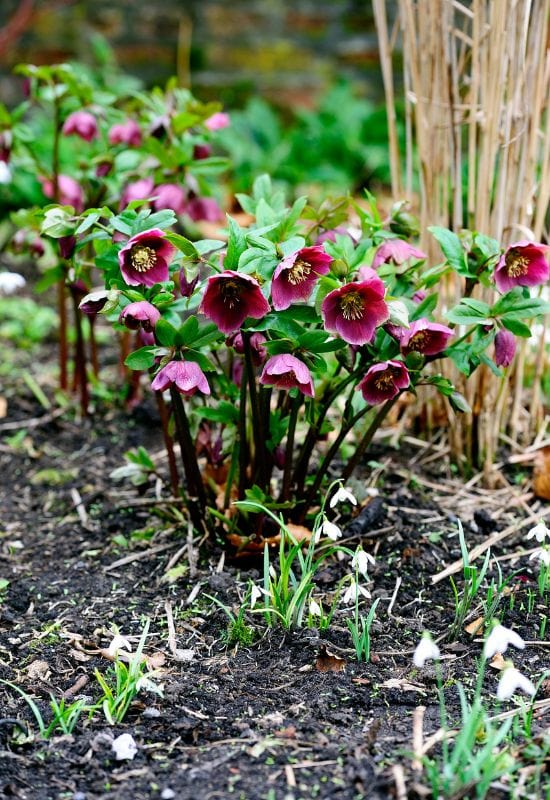
And in fact, hellebore is the little queen of winter gardens! Not only is it very cold hardy, but it actually likes cool temperatures, and most of its many varieties will be in full bloom during the winter months!
Some will start soon after, but still, all will survive temperatures as low as -30oF (-34.4oC)! So you can even enjoy their large blossoms, about 2 to 3.2 inches across (5.0 to 8.0 cm), sometimes looking outward, sometimes gently nodding, and with the most amazing palette at their disposal!
Yes, because this small, shrubby perennial has single or double blossoms in shades from white to “black” (very dark purple), with strong shades but also some of the mist delicate tonalities you can imagine, including rare greens, coral, salmon, peach, yellows, and many bicolor cultivars as well!
Generous with their floral displays, hellebores also offer you lush, soft looking, and always fresh evergreen foliage, with large and deeply cut leaves that form lovely clumps.
What is more, hellebores are shade loving plants, and they naturalize easily, no matter if you pick a rare cultivar… They are ideal for woodland gardens, but also in flower beds and to underplant shrubs or in shady borders. And, why not, if you want to have them in a container, please go ahead!
2: Snowdrop (Galanthus nivalis)
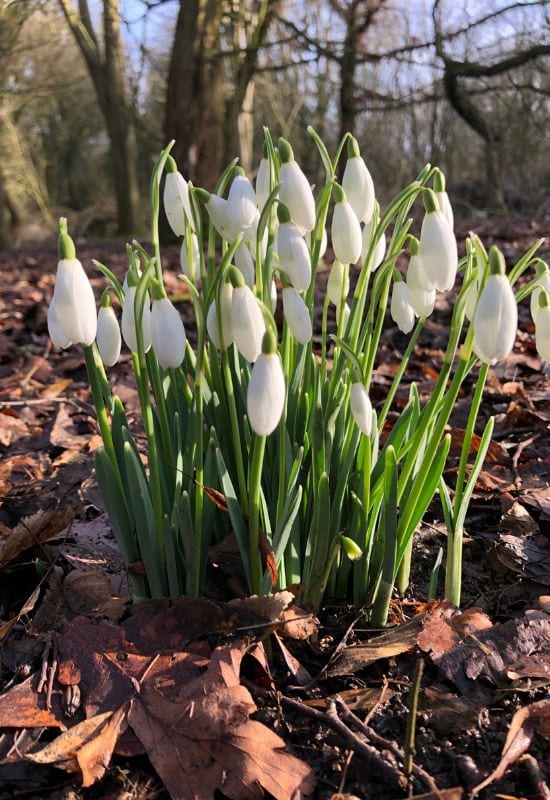
Could we forget snowdrop, a bulbous perennial with a winter inspired name, from our list? Certainly not, especially because it will survive temperatures that drop to a super freezing -40oF (or -40oC)!
So, you can grow it in most of Canada as well, and even on the coasts of Greenland! Winner of the famous Award of Garden Merit by the Royal Horticultural Society, the natural species, native to Europe, Galanthus nivalis, is arguably the most popular variety, thanks to its charming nodding and fragrant white flowers with a green dot…
They appear in late winter and they persist into early spring, really announcing the good season! The dark green, fleshy and strap like leaves we find at the base form an early tuft of foliage, which will then dry up and the whole plant hides into the bulb to withstand the sultry days of summer, when it is dormant.
But there are other varieties as well, including its cultivar ‘Flore Pleno’, with double blossoms, or the “giant” greater snowdrop, Galanthus elwesii, which has also win the RHS’s biggest prize, which looks a bit like a nodding tulip, also because its silver green foliage has the same shape.
Pick whichever snowdrop variety you like best for your garden, because they will all survive really harsh temperatures! Ideal to naturalize as well, these harbingers of spring are delightful if mass planted in woodland areas, great in rockeries, border fronts and under trees or shrub. Or they may offer you a sudden burst of candid blooms coming out of a lawn in late winter!
3: Garden Phlox (Phlox paniculata)
Famous for its heavenly fragrance, garden phlox will also survive ice cold temperatures of -40oF (or -40oC)! Rich in nectar, its flowers will blossom when winter has fully gone though, in during the hot summer months, and they will attract lots of pollinators and even hummingbirds!
They will open on round upward facing clusters dense with little flowers, in all shades of white, pink, rose, red, mauve, violet and purple! In fact, you can choose among more than 160 different cultivars, including bicolor ones.
While each blossom is only up to 1 inch across (2.5 cm), the overall effect is fantastic, for your nose as well. In fact, each panicle can be up to 8 inches in diameter (20 cm), and if you group plant them, you can get a real sea of color!
What is more, they grow on straight string and upward stems with lots of little, dark green and lance shaped leaves that give you the perfect bouquet variety…
A very hardy herbaceous perennial, garden phlox is a favorite in temperate and cold countries in borders and flower beds, usually group planted, and it will definitely suit most informal landscaping styles, especially if traditional in inspiration, but it is a definite must have in a cottage garden!
4: Horned Violet (Viola cornuta)
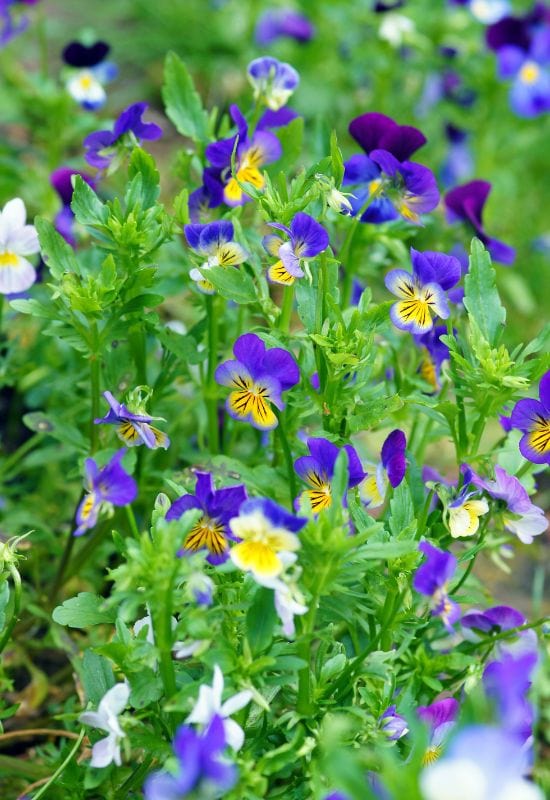
Most violet varieties are really cold hardy, but if you want a large, showy pansy, then the “horned” species and its cultivars will offer your garden a great perennial that will survive temperatures as low as -20oF (or -28.9oC).
Its blooms will appear in late spring, though some varieties may start even earlier, and, if they get enough fresh air, they can continue brightening up your days till fall!
Each blossom can be 1 to 2 inches across (2.5 to 5.0 cm), with the iconic round petals of different sizes of this genus, with a velvet texture, and a set of dark, radiant lines that lead you to the center.
When it comes to colors, it is just exceptional in range, with white and many bright shades of yellow, orange, red and purple. In some, you will find a dark patch in the middle, while ‘Blackout’ is literally one of the darkest flowers in the whole world: almost night black! This fragrant floral displays shines above a lovely tuft of bright green lobed leaves that provide the perfect backdrop!
One of the most popular perennials in low maintenance flower beds, horned violet is also great in rockeries, containers and woodland gardens, and for edging as well. If you want to go wild, you can even grow this pansy as ground cover, and, in any case, always group plant it for best effect.
5: Poet’s Daffodil (Narcissus poeticus var. recurvus)
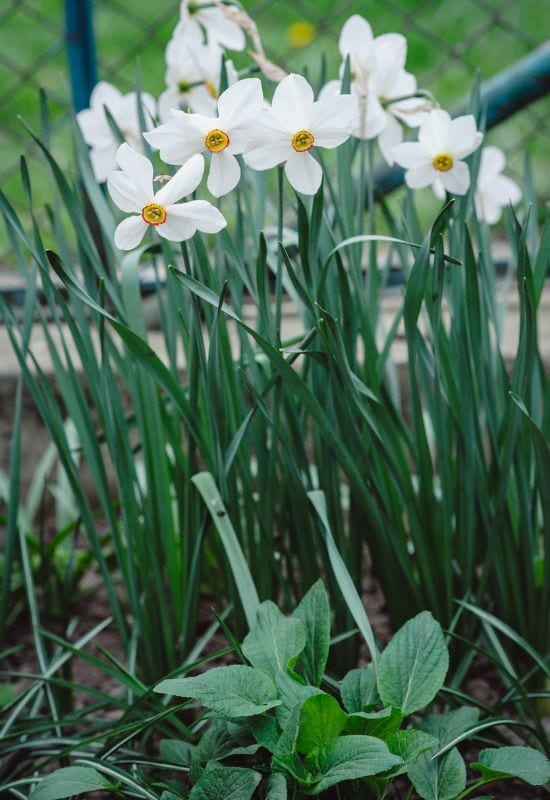
All daffodils will survive temperatures as low as -20oF (or -28.9oC), so, pick your own, but I would like to focus on a very special species: poet’s daffodil… And this is not only because Narcissus poeticus var. recurvushas a very evocative name… No, it will also grow in USDA zone 3, where winters can see the thermometer fall to a freezing -40oF (or -40oC)!
And it is also a winner of the Award of Garden Merit by the Royal Horticultural Society. But it is also a real classic of the genus, with smaller blossoms than trumpet varieties, as it grows spontaneously in many temperate and cold regions, on mountain highlands, where it can literally take over whole prairies and lawns, with an impressive display.
Blooming in late spring, the flowers are 2 to 3 inches across (5.0 to 7.5 cm), opening individually on top of upright stems. The five petals at the back are snow white, and very flattened out, while the central crown or cup is quite small, but bright golden orange, and in fact it is also called “pheasant eye daffodil”.
Filling your garden with its heady, heavenly fragrance, this floral display is accompanied by tufts of strap like but fleshy strap like leaves of a dark green shade, and a real wonder of Nature!
Perfect to naturalize in cold climates, poet’s daffodil is great also in rockeries, in wild prairies, to underplant trees and shrubs, in beds or border fronts. Do group plant it and let it spread, even under a lawn, and it will also thrive in containers and give you wonderful cut flowers!
6: Columbine (Aquilegia caerulea)
Native to Colorado, Montana, New Mexico, Wyoming and Utah, Aquilegia caeruleais a columbine variety that can withstand temperatures far below freezing, -40oF (or -40oC), in fact!
And there are now so many cultivars that your garden can fill with lots of colors from late spring to early summer, including its natural blue and white, but now also pinks, reds and yellows!
But the blossoms of this hardy species have other assets to offer you and your garden… To start with, their exquisite and unusual shape… With a central cup formed by five round petals (often in different tonalities from the rest), five rays to from it all around, it also has long conical, sometimes arching, deep filaments at the back!
They form dense clusters atop this small shrub looking perennial, even if each stem only bears a few blossoms, being very generous indeed. Loved by butterflies, bees, pollinators and also hummingbirds, this floral display rests on a leafy mound of fern like, deeply cut foliage, mid green in color and with amazing texture.
Yet another cold hardy perennial that naturalizes easily, this columbine is a must have variety in cottage garden, but also in traditional looking, old world flower beds and borders, to underplant trees and in wild prairies and meadows.
7: Chinese Ground Orchid (Bletilla striata)
No, it is not a nickname, Bletilla striata is real orchid species native to China, Japan and Tibet! And it will survive in your garden even if winters see temperatures as severe as -20oF (or -28.9oF)!
So, you too can enjoy its exotic beauty, and not worry about frost! True, you will have to wait till summer to enjoy its blooms, but then you will have a tropical looking perennial till mid season!
And its flowers are about 2 inches across (5.0 cm), with a long, tubular and gently downward arching labellum (the modified petal, or lip), with a decoration of vibrant magenta rose at the tip, highlighted by white stripes on its lower part.
The five, long and pointed tepals that frame it give you a lovely start shape, in lighter shades of the same color. These come on long, dark and thin racemes, opening from the bottom to the top.
Similar to cattleyas, these orchids grow from a pseudobulb at the base, which produces only 3 to 5 fleshy leaves, sword shaped, broad and pointed, with lovely lines in relief and a striking emerald color. And if you want some variation, the cultivar ‘Alba’ is snow white, while ‘Purple’ deepens its tonalities to bright purple – of course!
Naturally, cold hardy Chinese ground orchid, a.k.a. hyacinth orchid has won the much coveted Award of Garden Merit by the Royal Horticultural Society, and you can enjoy its exotic presence in flower beds, rock gardens, borders and containers. Yet again, it looks best if you mass plant it or just allow it to spread freely!
8: Daylily (Hemerocallis spp.)
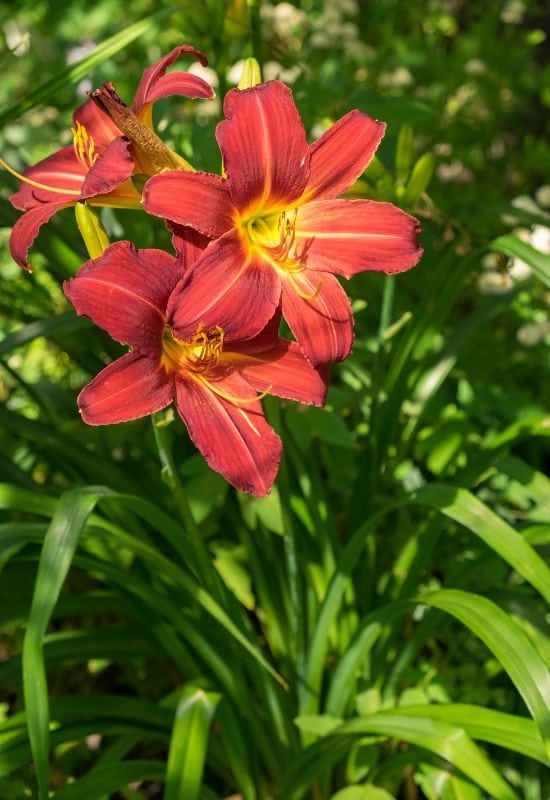
To prove yet again that the fact that you live in a region where winters are freezing does not mean that you need to renounce super showy, even exotic flowers… Enter daylily, or Hemericallis!
In fact, these amazing plants, regarded by some gardeners as the “perfect perennials” will come back year after year even if temperatures drop to -40oF (or -40oC)! As summer comes, they will give you their large lily like flowers, which can reach 8 inches across (20 cm), in huge numbers.
Each blossom will only last one day, but you will get so many that you won’t even notice! Super decorative, these blossoms can be of a magnificent range of colors, usually bright, including yellow, red, orange, pink, rose, purple, and even white!
I can’t give you the full range: suffice to say that there are a whopping 80,000 varieties you can choose from! Double flowered ones are also available, and many prize winners as well, but single ones will be better magnets for butterflies, bees and other pollinators.
The very long, dark green, flashy strap shaped leaves that arch in tufts at the base of this amazing floral display will fill your garden with fresh looking, lush and semi glossy foliage as well! And some are also evergreen!
Daylilies are the queens of borders, super easy to grow, extremely rewarding, showy and exotic looking, they are really ideal for informal and natural looking gardens in temperate and even cold regions. And these perennials too will spread fast and naturalize, even if they look like they come from a rain forest but winters are freezing!
9: ‘Purple Emperor’ Stonecrop (Sedum telephium ‘Purple Emperor’)
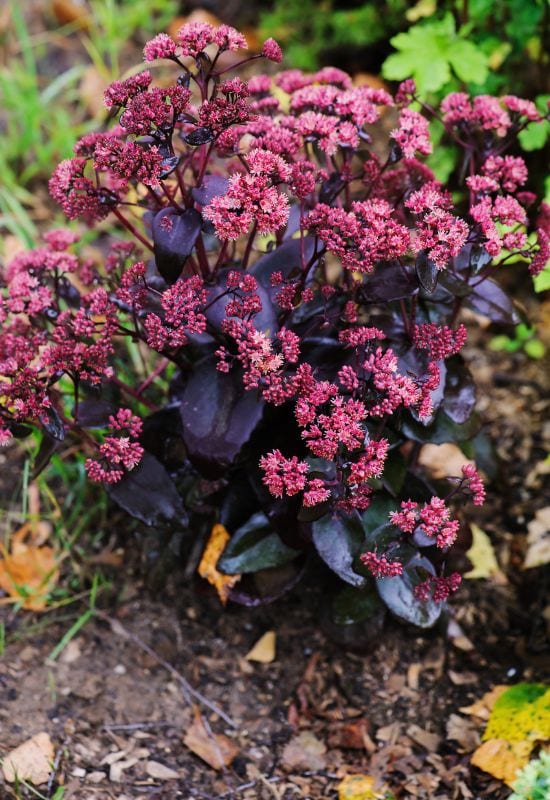
Now, I am going to surprise you! You don’t expect succulents to tolerate cold temperatures, but some, like hens and chicks (Sempervivum spp.) and yucca, manage USDA zone 5, but the hardiest of all must be stonecrop, which can grow in USDA zone 3, where winters can see the thermometer drop to -40oF (and -40oC)!
Not all varieties will survive such severe climate, but you could grow moss stonecrop (Sedum acre), with lovely golden yellow blooms, or ‘Frosty Morn’ (Sedum erythrosticum ‘Frosty Morn’), with its blue and white foliage. But maybe ‘Purple Emperor’ (Sedum telephium ‘Purple Emperor’) is the one that really looks out of place in your area… And why?
Just look at the very deep, strong burgundy leaves that grow on its little stems, super glossy, and with gently crenated margins! It will really stand out in your garden, all year round, as it is evergreen!
And then, starting in mid summer, it will produce stems with lovely round clusters of bright rose pink, star shaped little flowers! And they will keep brightening up your days till the month of October!
Easy to grow, vigorous and with incredible colors, ‘Purple Emperor’ stonecrop is a small, bushy succulent with such a strong presence that it will lift your flower beds, rock garden or containers no matter how ice cold and snow white it gets!
10: Plantain Lily (Hosta spp.)
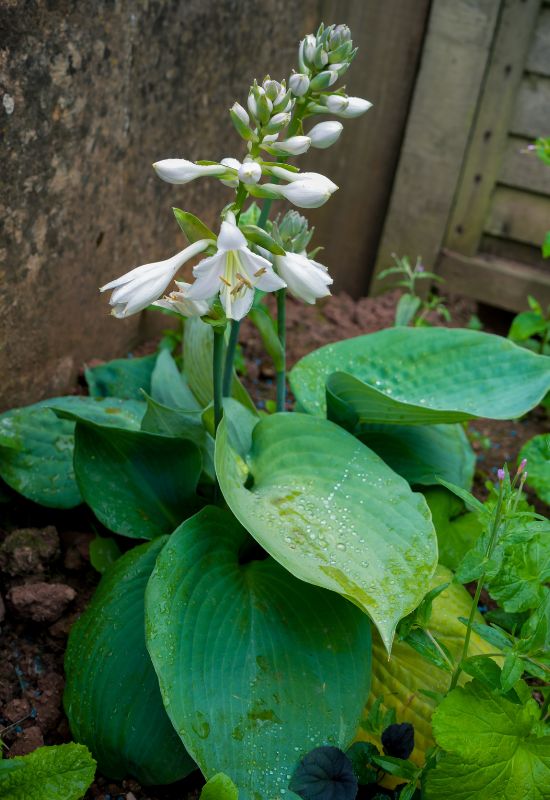
Plantain lily, or simply Hosta, is a favorite perennial, especially in shady gardens, and it really likes fresh air. Actually, it is very cold hardy, despite its soft and tender personality, as it can resist temperaturesfar below freezing: -40oF, or -40oC!
With its lush, decorative and large heart shaped, lance shaped or cupped leaves, depending on the variety you pick, it created attractive mounds that last all through the season.
And you can pick the color, with greens, including chartreuse, lime and emerald, blue, including silver and aquamarine, yellows and white, and many variegated choices as well. But this plant also has lovely floral display during the summer season, with stems that bear trumpet shaped blossoms, in white, lavender, pink, pale blue and even purple!
Some also have a sweet scent as well, like winner of the Award of Garden Merit by the Royal Horticultural Society ‘Fragrant Bouquet’. And you can also choose among larger and smaller ones; while most keep within two feet tall and in spread (60 cm), there are some that reach 6 feet wide (1.8 meters) and 4 in height (1.2 meters)!
Plantain lily hit a wonderful balance between an exotic personality and a fresh, traditional look. Native to China, Japan and Korea, this cold hardy, frost tolerant garden favorite will look great even in orientally inspired spaces, and your worry won’t be the cold… No, they are magnets for slugs and snails, so, look out for them, and try to protect their soft and juicy leaves!
11: Bearded Iris (Iris germanica)
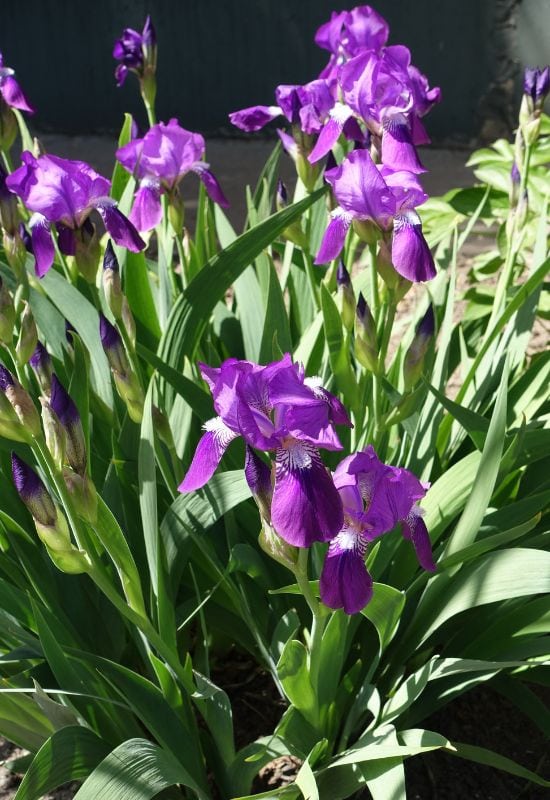
One of the most showy iris types (or species) in the world, bearded iris is also very, very cold hardy indeed! In fact, it can survive in temperatures that drop to a freezing -40oF, or -40oC, and you can grow it in the coldest regions of the USA or virtually in the whole of Canada!
Despite its scientific name, we don’t know where it really comes from, but probably from the Mediterranean Basin, not Germany… And in fact, it will give you those amazing terminal clusters of 3 big blossoms, at the tip of a straight stem, which are literally iconic.
All consist of standards, or top upright petals, and falls, those lip like lower petals, where you can usually see a signal, or a usually golden patch, to tell pollinators where to land… But this perennial also has a “beard” on it… It is actually a tuft of stamens that deposit pollen on little visitors.
In blossom from late spring to early summer, you can choose so many varieties of different colors, from white to yellow, orange, pink, red, blue and purple, to even almost black (‘Before the Storm’)!
It is also a semi evergreen plant, with really striking blade like, fleshy leaves that hit lovely notes of bluish and silver, and may persist under heavy snow!
Easy to grow and very rewarding, bearded iris is one of the best cold hardy, frost tolerant and proof perennial blooming plants to grow in areas where winters are freezing, including on mountain areas, in informal and sunny borders or beds and it also gives you wonderful and long lasting cut flowers.
12: Crocus (Crocus spp.)
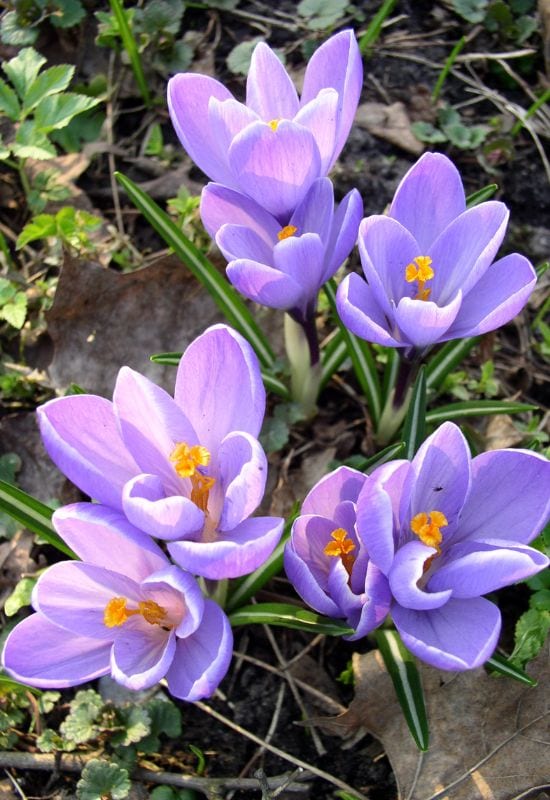
Here is another bulbous perennial that can survive temperatures to make your teeth chatter, -40oF (or -40oC), and a garden favorite: the little crocus.
Yes, it is a tiny harbinger of spring, actually some varieties blossom in late winter, and pop their sweet looking cupped flowers out of a carpet of snow, in some regions… And they are a real delight!
Of course, there are 80 to 100 different species and a much bigger number of cultivars you can choose from. So, you can choose one in a range of colors, including white, yellow, orange, lavender, blue and purple!
Variegated blossoms are also available, and all open close to the ground, looking up to the sky and first rays of the Sun… You will never get a big plant from them, but this is part of their charm, but you can get a range, from the pygmy crocus (Crocus minimus) which hardly ever reaches 4 inches tall (10 cm) to the Dutch (or giant) variety (Crocus vernus) with bigger, rounder blossoms and up to 6 inches tall (15 cm).
All will also give you a little tuft of dark green, pine needle like leaves at the base, which look like a little effort compared to their floral display, and they will soon disappear into the corms underground as soon as the weather gets warmer, waiting there for a new cold season to come and wake them up.
One of the great garden values of crocuses is that they bloom early and you can easily naturalize. Once you plant the corms, they will spread naturally, and over time, you can have full lawns exploding with colorful flowers.
I have seen a whole Valley in the Alps literally filled with them. Great in flower beds or rock gardens as well, these little perennials will never disappoint!
13: ‘Black Princess’ Hardy Water Lily (Nymphaea ‘Black Princess’)
We think of water lilies as tropical perennials, but there are hardy ones as well, and we picked an exceptional one for you: ‘Black Princess’. It is hard to believe looking at it, but it will tolerate extreme temperatures as low as -40oF (or -40oC)!
Yet, it will give you its wonderful exotic looks, and much, much more! Let’s start with its blooms… They will start in late spring and keep coming till the end of the season, to start with!
With fleshy, glossy, and lustrous petals, they form the classical rosette shaped you wild expect from a Nymphaea floating on the surface of your pond… And you can grow it even if the water is quite shallow, 6 inches (15 cm) are enough!
And then, you will be amazed by its impressively deep, sumptuous dark ruby red color! And each blossom can reach 6 inches across (15 cm)! Its flowers are also fragrant, and they open during the day and close again at night.
This can be enough to convince you to grow one, but wait… Its round and shiny leaves, about 8 inches across (20 cm), are not green as you would imagine… Well, they will become a beautiful shade of emerald as they mature, but they unfurl in purple, and keep so for a very long time!
You can choose other hardy varieties of Nymphaea, most suitable to USDA zone 4, but ‘Black Princess’ really gives you an incredible performance and it is really adaptable to shallow water and small ponds, and one of the most impressive of all!
14: Lily of the Valley (Convallaria majalis)
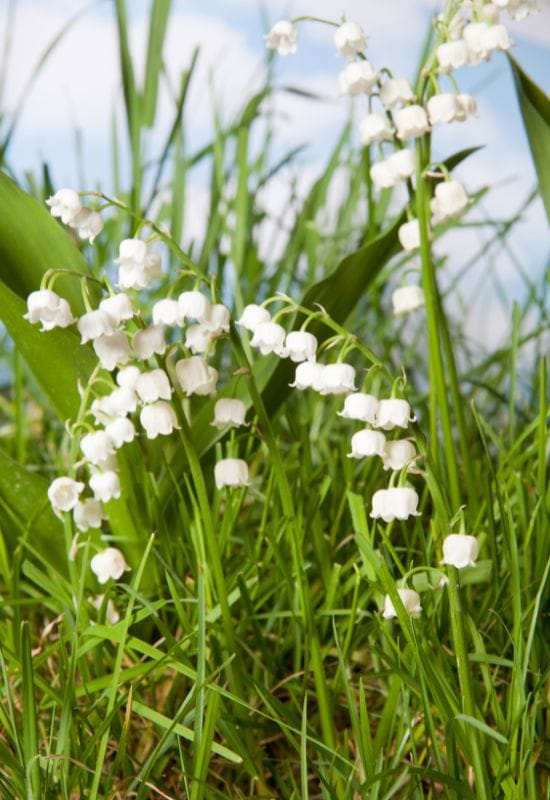
You can literally grow lily of the valley even in the coldest regions of Canada and the USA, in fact, anywhere where you can grow a plant that’s not a lichen… It will tolerate temperatures to daunt a mammoth, in fact, as low as -50oF (or -45.6oC)!
And it is also a leafy beauty that grows well in shady gardens… Talking about which, this rhizomatous species is famous worldwide for its lush, broad and pointed foliage, fairly fleshy and glossy in texture, and it does not need to be all emerald green… For example, the variegated cultivar ‘Albostriata’ offers you stripes in butter yellow as well!
And as soon as the snow thaws in cold regions, a slender, elegant and arching stem will bear about a dozen white, bell shaped flowers, which are also fragrant! These are not big, but they are really decorative blossoms, and some varieties, like ‘Bordeaux’ have bigger blossoms than most.
What is also great about Convallaria majalis is that it is really low maintenance and it will tolerate harsh conditions very well, spreading naturally on your land and asking virtually no care.
Loved as ground cover, lily of the valley is a really cold hardy perennial that you can also enjoy in rock gardens, flower beds or to underplant shrubs and trees. It will also give you lovely cut flowers, but do remember that it is toxic if you ingest it.
15: Bushy Aster (Aster dumosus)
Most aster types are cold hardy, including the popular New England species (Aster novae-angliae), to USDA zone 5, but A. dumosuswill tolerate even colder temperatures, to -30oF (or -34.4oC).
Also called Michaelmas daisy, it forms very dense but comparatively low clumps, that look shrubby, in fact, as you would guess… Native to North America, it fills with very fine foliage, made up of lots of tiny, pointed leaves, of a mid to very dark green tonality.
But of course, we all know these garden favorites for they daisy like blossoms, which in our case are usually less than an inch across (2.5 cm). And you will get such a generous bloom, that they will literally cover the whole plant from late summer to the first frost!
They are less suitable as cut flowers, having shorter stems than her sisters, but the spectacle is great. And there are many cultivars you can choose from, for example one of my favorites,‘Prof.
Anton Kippenberg’, with heavenly sky blue petals, or the rose pink and romantic ‘Jenny’ as well as many other varieties along the purple and violet range, like the famous lavender colored ‘Siberhlaukissen’, with an icy look. All, however, will literally fill with butterflies and other pollinators who come to feed till the end of the season.
For this reason, bushy aster is a favorite cold hardy perennial for butterfly gardens, but it is also excellent in herbaceous borders, and a must have plant to grow in a traditional looking cottage or English country garden.
16: Martagon Lily (Lilium martagon)
Sun loving, showy, iconic and with an exotic look, real lilies (Lilium spp.) can be quite cold hardy indeed. So, for example, Asiatic, oriental and orienpetvarieties will grow in USDA zone 4, while even trumpet ones can survive in USDA zone 5.
But if you want bulbs that will survive to -40oF (or -40oC) look at the Martagon group. For example, ‘Orange Marmalade’ offers you a long, upright and purple stem that bears up to 30 blooms, each with recurved petals and with a very vibrant carrot to tangerine tonality.
Excellent cut flowers, they will grace your garden un early and mid summer, as will other cultivars by the same breeder. And so, ‘Manitoba Beauty’ has up to 50 heads, all nodding beautifully and with the most impressive magenta ever, as well as very decorative, large, golden anthers that extend below, together with a pistil with purple stigma!
Similar is also ‘Fairy Morning’ but soft shell pink, with dark burgundy spots and dark yellowish margins! These floral candelabras are real show stopper even in cold countries, each blossom being between 2 and 4 inches across (5.0 to 10 cm), and all will offer you the pointed lance shaped leaves that climb up the stem from low down near the ground.
Great for pollinators and butterflies, Martagon lilies will come back year after year in borders or beds as well as containers in gardens which see really freezing winters, and, of course, they are outstanding cut flowers, like their more famous sister varieties. Actually, they give you smaller blooms, yes, but un jaw dropping numbers.
17: Tulips (Tulipa spp.)
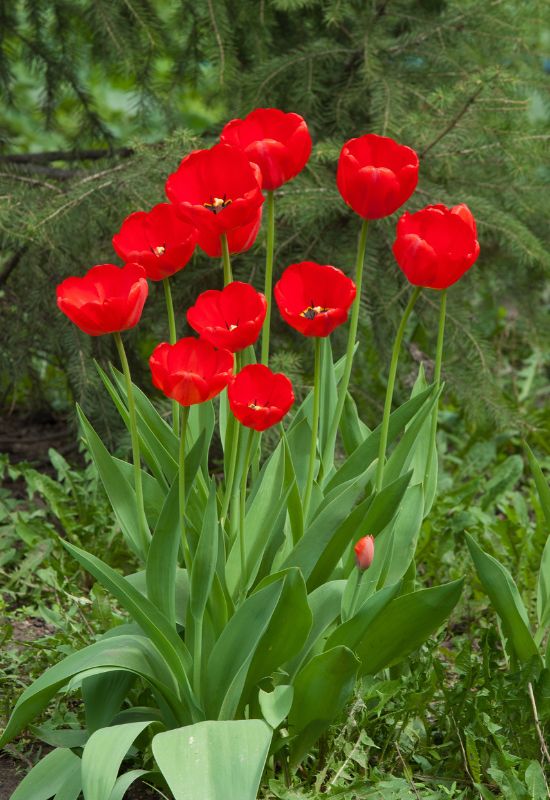
In fact, if you live in a country where winters are cold, you may even count yourself lucky! Yes, because tulips actually like it!
Because the most popular and famous bulbous perennials in the world do have a very exotic, actually oriental look, but they originate from Central Asia, where they have been cultivated as early as 1,000 CE, and where temperatures drop to extremely low temperatures.
And, in fact, their bulbs will live underground even if the thermometer drops to a freezing -40oF (or also -40oC)… And the fact that they are mainly grown in the Netherlands now confirms this preference for a “very fresh” season to wake wake them up…
And of course, tulips come in so many colors, with white, yellow, orange, red, purple and almost black, even green, but also shapes, with the classic egg shaped ones, but also lily flowered varieties, cupped, single and double heads… the largest blossoms can reach 10 inches long (25 cm), and yes, they open in the day and usually close back at night.
Its fleshy, broad and lance shaped leaves usually have green to silver bluish in color, but look at the amazing Tulipa greigii and you will also find stripes of purple, yellow and pale blue!
Of course, tulips are kings of flower beds and borders, but also excellent and much loved cut flowers in cold countries, you should plant the bulbs early, from September to October in USDA zone 3, late September to early November in USDA zones 4 and 5, and October to Mid December in USDA zones 6 to 7.
18: Blanket Flower (Gaillardia spp.)
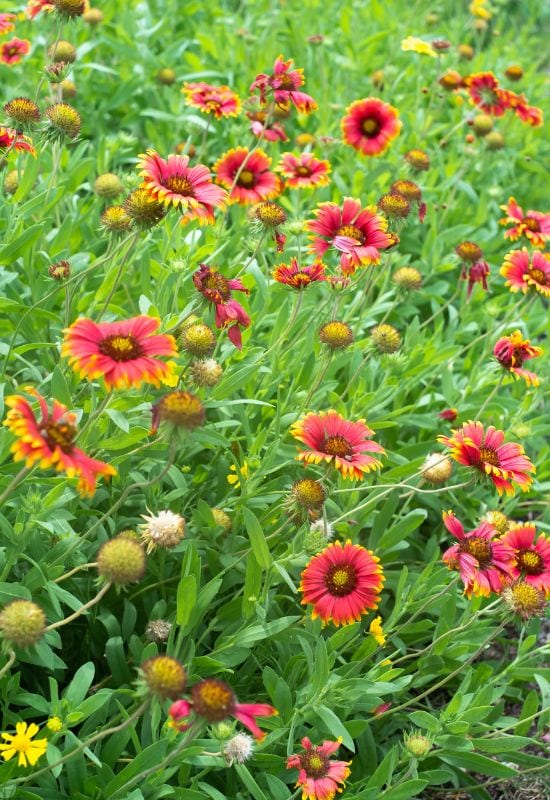
But if you really want to bring the colors of Mexico to your garden in a cold region, blanket flower is the perfect perennial for you! Native to both North and South America, this plant expresses the heat, even sultry sunlight of hot countries, with bright reds, yellows and oranges!
And it is cold hardy to USDA hardiness zone 3 (-40oF and -40oC). You will have to wait till early summer to see it in bloom, but then it will keep warming up your haven till late fall! All through this time, you will enjoy its daisy like flowers, which are 2 to 3 inches across (5.0 to 7.5 cm), looking up to you and the sky.
With a large central disk and many long and thin petals, they will attract lots of butterflies, bees and other pollinators all through the season, forming a sea of light and energy! And that’s why it has this name, because it literally forms a blanket with its blossoms!
There are now many hybrids and cultivars to choose from, including bicolor varieties like the popular ‘Arizona Sun’ (scarlet and golden) and ‘Fanfare’ with ray flowers in the shape of trumpets, crimson and honey, both of the Gallardia x grandifloraspecies.
Under this floral display, you will see a lush mound of bright to mid green leaves, lance shaped, but in some cases lobed, which will die back when winter comes, and grow again in spring.
An absolute wonder in cottage and butterfly gardens, blanket flower will also look great in flower beds and borders, or even wild prairies and meadows, or in a decorative vase after you have cut it. And it is also excellent to bring the colors of the Sun next to the sea, or on a coastal region.
19: Evergreen Candytuft (Iberis sempervirens)
If instead you want to prolong the mantle of snow effect even when it has finally thawed, a lovely frost tolerant perennial from southern Europe will help you achieve this in your garden: turn to the evergreen candytuft. Cold hardy to USDA zone 3 (which is -40oF, or -40oC), this low and sprawling plant will start early in the season with its candid floral display.
In fact, come mid spring, it will turn fully white! And this is due to a huge number of round clusters of little flowers that literally cover the whole plant. Look closely and you will see that each tiny blossom has four petals, but the two that point towards the middle of the raceme are smaller, and the ones pointing outwards are bigger.
And the more you get towards the edges, the longer they get. This gives them a very artistic shape, soft and smooth, but if you look even closer, you will see the golden yellow of the reproductive organs nestled inside the blossoms.
However, you can now grow varieties in lavender to purplish, like the cultivar ‘Absolute Amethyst’ if you prefer a change from the cold season. A favorite floral display with butterflies, it will cover a mound of very fine, bright to mid green little ovate leaves, which, despite its name is semi evergreen, to USDA zone 5 and above, usually.
A sweet looking and frost resistant perennial, evergreen candytuft is a perfect choice for edging, raised beds, containers and ground cover. And it will suit informal gardens where it can bring a white and candid definition of pathways or to delimit borders.
20: Glory of the Snow (Chionodoxa spp.)
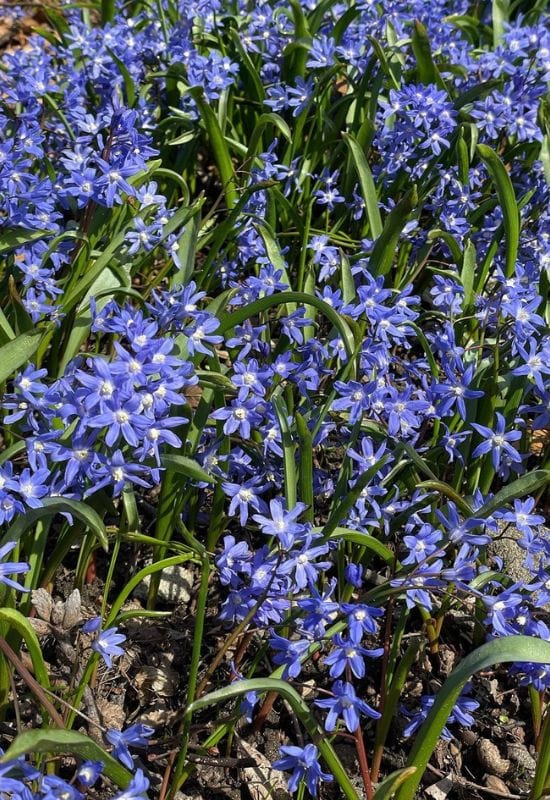
It seems natural to conclude our list of frost tolerant perennials with the little bulbous glory of the snow, which tolerates temperatures as low as freezing -40oF (and -40oC). And it will blossom early in the season, even if your garden is still covered in the white coat of winter!
Native to the Mediterranean, it grows on alpine pastures, where it offers wonderful shows with its star shaped blooms! They come in loose clusters, of up to 12 little flowers, star shaped and very much reminding us of miniature lilies…
The heads will look outward, with their six fleshy petals, in different colors, and you can pick white, blue or lavender, including the cultivars ‘Blue Giant’, ‘Pink Giant’ and ‘Violet Beauty’ (all Chionodoxa forbseii cultivars).
Or you can choose the deep sky colored lesser glory of the snow (Chionodoxasardensis, or Scilla sardensis), native to Turkey and winner of the Award of Garden Merit by the Royal Horticultural Society.
But if you want pure ivory, then Chionodoxaluciliae ‘Alba’ could be the best choice, whose blossoms look upward, unusually. All will also offer you glossy long, arching and emerald green foliage till they hide into the group and to rest during the warmer months.
One of the best coldhardy but also graceful frost tolerant bulbous perennials, glory of the snow is perfect to announce spring in rock gardens or flower beds, but also under trees in woodlands and to spring up in lawns in early spring, and it will also naturalize well and spread spontaneously. It is best to mass plant them and to mix them with other spring bulbs, like crocuses and daffodils.
Lots of Wonderful Frost Tolerant Perennials for Gardens in Cold Countries!
Let’s admit it… These very cold hardy flowering perennials can warm up your days, some even in winter, and the others will do it at other times, but they will never succumb to low temperatures, so you needn’t worry; they will come back with their amazing blooms year after year and never let you down!
As you can see, you don’t even have to stick with temperate looking varieties. There are even exotic perennials, like tulips, lilies and even some orchids that can tolerate really freezing temperatures!
So, whatever your garden style, even if it is covered in a thick blanket of snow form many months, and even if you need to wrap up warm through the whole season, these super frost tolerant plants will grow, thrive, and even naturalize!

Written By
Amber Noyes
Amber Noyes was born and raised in a suburban California town, San Mateo. She holds a master’s degree in horticulture from the University of California as well as a BS in Biology from the University of San Francisco. With experience working on an organic farm, water conservation research, farmers’ markets, and plant nursery, she understands what makes plants thrive and how we can better understand the connection between microclimate and plant health. When she’s not on the land, Amber loves informing people of new ideas/things related to gardening, especially organic gardening, houseplants, and growing plants in a small space.

